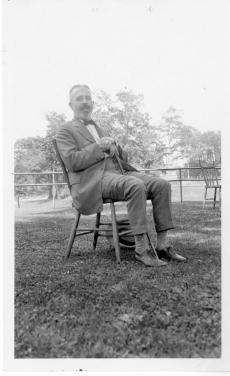During Science Service’s first year, director E.E. Slosson and his managing editor, Howard Wheeler, worked diligently to persuade their newspaper clients to include more science content. To survive in the marketplace, they had to attract potential clients (and readers) with interesting topics. And yet, the fledgling service could not afford to alienate the wider scientific community, whose notions of “popular science” leaned toward the conservative and who decried any hint of sensationalism.
Wheeler’s correspondence in 1921 with one syndication service (as preserved in RU7091, Box 10) is typical of the negotiations.
![June Etta Downey (1875-1932), Smithsonian Institution Archives, SIA Acc. 90-105 [SIA2008-1400]. June Etta Downey (1875-1932), Smithsonian Institution Archives, SIA Acc. 90-105 [SIA2008-1400].](https://ids.si.edu/ids/iiif/SIA-SIA2008-1400-000001/full/250,/0/default.jpg)
“The fastest thing in the world (light)”
“The smallest living thing (filterable bacteria)”
“The sweetest thing (whatever it is, probably saccharin)”
“The fastest growing thing (bamboo if you mean size, yeast if you mean number)”
“The coldest thing (liquid helium)”
Wheeler knew that readers liked puzzles, mysteries, and intriguing questions like “why does glue stick?” He even suggested the ultimate story line: “‘The Possible End of the World’ as evidenced by “slow cooling, destruction by collision, bacterial attack, failure of the world’s electrical field, or volcanic disruption.” “There is abundant material” about such potential catastrophes, he assured his correspondent.
Authors of two of the suggested series were women scientists.June Etta Downey (1875-1932), professor of psychology at the University of Wyoming, was described as “one of the most original thinkers in psychology.” Downey had agreed to write three articles on “human speed limits.”
![Charles Benedict Davenport (1866-1944), Smithsonian Institution Archives, SIA Acc. 90-105 [SIA2008-0872]. Charles Benedict Davenport (1866-1944)](https://ids.si.edu/ids/iiif/SIA-SIA2008-0872-000001/full/250,/0/default.jpg)
Editors responded enthusiastically to good topics but appear to have paid less attention to the potential author’s credentials. In April, for example, Science Service attempted to broker an article called “The Motion of the Stars,” written by C. C. Abbot. “The measurement of star distances is one of the most difficult astronomical subjects to handle popularly,” Wheeler wrote, and “even though Dr. Abbotts [sic] discussion will require close reading by the layman,” the piece is “as simple and lucid as any strictly accurate discussion can be made.” Unfortunately, newspapers editors did not agree, and the manuscript by a well-known astronomer (and future Secretary of the Smithsonian Institution) was rejected.
In May, at the urging of the syndicate editor, Wheeler submitted his first package of completed manuscripts. It included “The Lightest Thing in the World” (written by chemist Harrison E. Howe), “Can You Make Yourself Like Your Wife’s Hat?” (by New York University psychology professor Walter Broad Veazie), and “Why Sons So Often Resemble Their Mother’s People” (by Gertrude C. Davenport).

Similar dialogue between the science news service and the syndication services continued in the following years, and the clients’ suggestions can often seem very familiar. One editor, for example, urged more sensitivity to timing (do not send articles about oysters during the summer) and emphasized that sensationalism always sold. He “would not object,” he wrote, to “articles pitching in to superstitions such as the Ouija board, sexometer and so forth.”
Related Resources
Women in Science Wednesday: June Etta Downey, The Bigger Picture Blog, Smithsonian Institution Archives.
June Etta Downey (1875-1932), Flickr, Smithsonian Institution Archives.
Produced by the Smithsonian Institution Archives. For copyright questions, please see the Terms of Use.

Leave a Comment